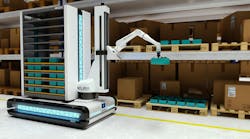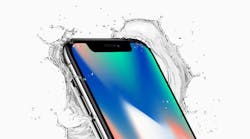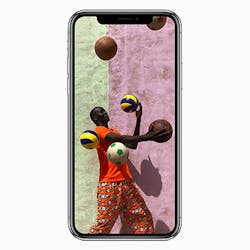For most of us, the Apple iPhone X's initial $999 price tag will be a bit too steep to get right away, even if you are able to sign over your soul and first born to one of the major carriers for a sweet discount. Which means, unless you’re still free of children and mortgages and the costs of grownup life, you'll probably have to wait to take advantage of its retina-scanning security, bleeding edge six-core processor, or hassle-free wireless charging mat.
Personally, I downgraded my smartphone due to my toddlers' belief that it is their property. What good would the 7-megapixel TrueDepth camera be with peanut butter and boogers smeared all over the lens?
But that doesn’t mean we shouldn’t all be excited at what these new features could mean for Big Tech in the next few years. As New York Fashion Week this week inspired next season's hottest clothing designers — and nightmares everywhere — with haute genitalia-adorned outwear, the innovations bursting forth from Cupertino will no doubt set the pace for the mobile computing world as we roar into the 2020s. And as the Apple's previous big launches have proved, this space has the capability to redefine everything from how we communicate, how we work, and how we interact with world around us.
For instance, instead of paper checklists at the plant, tablets are the norm. Microsoft invented one at the turn of the millennium, but it wasn't until the iPad in 2010 that the tech truly took off. After that, other companies mimicked the form and features while upgrading durability and power for industrial environments.
One can only guess how the new Apple Watch Series 3 will affect plants. For the first time, you will be able to make a call only speaking into your wrist, no phone necessary: a geek goal since the days of Dick Tracy and Michael Knight. Our editor Travis Hessman wistfully imagines a life not shackled to a phone, but a utilitarian life in which all his communication needs and access to the totality of human knowledge are still fulfilled. Maybe the new watch will accomplish that. And on one cuff, no less.
It's easy to dream up how that type of hands-free communication will affect technicians and maintenance workers, though wearable headsets already provide that as well as several more features in a much more rugged package.
That's why the innovations to explore here lie within the iPhone X. Here's what the new super new smartphone claims to offer, and how it could inspire and impact the industrial workforce:
A11 Bionic
The six-core CPU offers "two performance cores that are 25% faster and four efficiency cores that are 70% faster than the A10 Fusion, offering industry-leading performance and energy efficiency," Apple says. And the performance controller increases multi-threaded workload by 70% and improves upon battery life by two hours over the iPhone 7. This is the brain of the machine, allowing for all amazing new features to function by performing up to 600 billion operations per second.
The neural engine was engineered for "specific machine learning algorithms," so it will only get smarter over time. Industry is pretty on top of machine learning and big data, but with several new portable AI minds working around the clock at your plant, the amount of data collected could exponentially increase efficiencies and expose safety flaws. Or they'll all band together and become a Stephen Kingian smart factory of horrors.
Charging Pad
Wireless charging not only ends the search through a table of various cables to find the right connector, but you won't have a charging dock that could potentially be damaged over time due to clumsily inserting the plug in the dark. In the plant, some AGV makers have already experimented with wireless charging while cargo is loading and unloading, reducing the fleet's downtime and potential to damage.
Face ID
Via the 7-megapixel screen-side True Depth camera, comprising a dot projector, infrared camera and flood illuminator, the iPhone X's A11 Bionic processor will create a map of your face that acts as the key to unlocking the device. It uses 30,000 IR points and advanced depth sensing, so it will be quite difficult to trick the system with a cardboard cutout of the true owner's mug. On top of that, the neural network senses small changes over time, meaning it will account for your male pattern baldness.
What it could inspire: Retina scanning has been around for 40 years, but biometric security isn't as ubiquitous as every spy movie ever will have you believe. With all the various cybersecurity threats out there, it would make sense for new robot training pendants or next-gen machining applications to have the same level of security. Only approved faces can start certain operations. That would prevent a hacker from hijacking the WiFi signal and taking over your equipment. It could even be tied to certifications and compliance. If you aren't qualified for certain high level operations, the machine won't work. Think of it as a visual Lockout/ Tagout system. The only issues going forward are if someone kidnaps your identical twin, creates a clone of you, or most likely, recruits Nicholas Cage to cuts off your face and attach it to his own.
TrueDepth Camera
Along with an enhanced image signal processor that does real-time lighting estimation, the camera autofocuses faster in low light and is fitted with individually calibrated sensors such as new gyroscopes and accelerometers for accurate motion tracking. Apple says it's "custom tuned for the ultimate AR experience."
What this means for industry is that more companies will work on their own augmented reality apps, thus increasing the amount of apps that manufacturers will be able to use for design, safety, and day-to-day plant monitoring. Trying to predict exactly how this will revolutionize industry would be foolish. It's a guarantee that this technology, which serves as the tether between our digital and physical realities, will only grow in importance in the coming years. Hell, we can now have lightsaber battles with our phones. Anything is possible.













